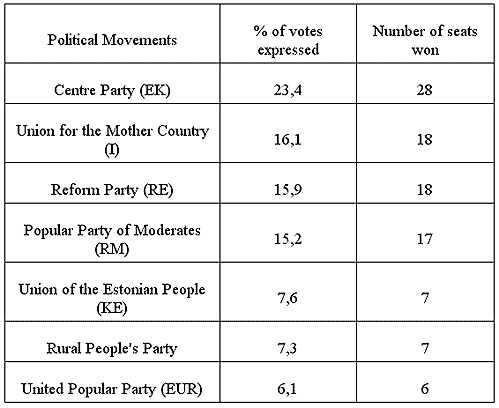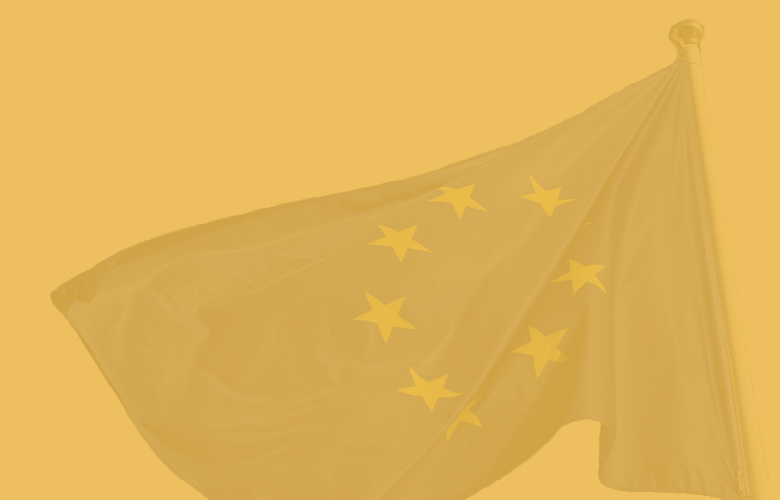News
Corinne Deloy,
Fondation Robert Schuman,
Helen Levy
-

Available versions :
EN

Corinne Deloy
Fondation Robert Schuman
Helen Levy
On 2nd March, little more than a year after the change of Prime Minister that came a year of political turbulence, Estonia will elect a new parliament. On 8th January 2002 after numerous disagreements between the different government parties (Centre Party, EK, Reform Party, ER, and the Union for the Mother Country, I), Prime Minister Mart Laar (Union for the Mother Country) resigned, leaving power in the hands of the Centre and Reform Parties. Since the Union of the People and the Popular Party of Moderates (RM) refused to form a coalition with the Reform and Centre Parties the latter finally created a government led by Siim Kallas (Reform Party), Finance Minister of the previous government, former governor of the country's central bank and father of the Estonian Crown that replaced the rouble in 1992. This iconoclastic alliance of two movements that are political opposites (the Centre Party tending towards Social Democracy and the Reform Party lying on the right of the political chessboard) is not due to survive the upcoming general elections.
The Estonian Political System
Since the country's independence that was regained on 20th August 1991, the 100 members of the Riigikogu (Mono-cameral Parliament) are elected every four years by a proportional voting system. According to the Constitution, adopted by referendum in1992, Estonia is a parliamentary democracy in which the President (at present Arnold Rüütel) is elected every five years by parliament, according to a complex system, has very little power.
The proportional election system practised during the general elections has been at the centre of many political debates in the country. Each voter selects a candidate who will be elected or not according, on the one hand, to the number of votes won nationally by the movement he belongs to, and on the other hand the place the candidate occupies on the list put forward by the party. A movement has to win a minimum of 5% of the votes expressed in order to be represented in the Riigikogu. Each Parliamentary candidate has to be at least 20 years old and master the Estonian language. Apart from the Prime Minister the Estonian government comprises 12 members. The government is always a coalition since it is not necessarily formed by the head of the movement that won the election. Hence the Centre party, that was the victor in the last general elections in 1999 with 23,4% of the vote, found itself on the opposition benches after the Union for the Mother Country, the Reform Party and the Popular Party of Moderates came together to create a coalition.
Not many Estonians usually turn out to vote. Only 67,5% of them voted during the general elections of 1992 and 57,3% in 1999. Local elections do not attract any more voters either, participation reaching 52,7% during the 1993 election and 50% in 1999. At the start of the 1990's the return of democracy saw the birth of a number of political movements that have merged together since. Whilst in 1992 38 movements participated in the general elections, there were only 12 taking part in 1999. Only three parties, the Reform Party, the Centre Party and the Union for the Mother Country took part in the last two general elections in 1995 and 1999.
Ten parties are represented at present in the Riigikogu :
- The Centre Party (EK), a centre left movement with the greatest number of MP's (29) ;
- The Reform Party (ER), the Prime Minister Siim Kallas' liberal party founded in 1994. It has 18 MP's;
- The Union for the Mother Country (I), a Christian Democrat movement comprising 18MP's;
- The Popular Party of Moderates (RM), Social Democrat Party led by Toomas Hendrik Ilves, the country's most popular politician after the present President of the Republic, Arnold Rüütel. It has 17 MP's;
- the Assembly for the Republic - Res Publica, a movement created by a right-wing think-tank and led by the political analyst Rein Taagepera ;
- The United Popular Party of Estonia;
- The Popular Union of Estonia;
- The Social Democrat Labour Party;
- The Party of Baltic Russians in Estonia;
- New Estonia.
The Estonian partisan system is close to the Scandinavian one - and can be divided into four trends of almost equal importance: the conservatives, the liberals, the social-democrats and the agrarians. Estonia does not have an extremist or a truly populist movement.
The situation of the Russian speaking minority and the language problem.
Estonia is the least populous of the three Baltic Republics. It has 1.6 million inhabitants of whom 61.5% are Estonians, 29% Russian (i.e. 400,000 people), 3.1% Ukrainian and 1.8% Byelorussian. The country is in fact more Nordic than Baltic, since Estonian is not an Indo-European language but belongs to the Uralic family that also includes Finnish and Hungarian.
Just after independence the new legislation postulated that all of those living in Estonia before 1940 including their descendants would automatically be attributed with Estonian nationality. A three year residence permit is granted to the other citizens who are also obliged to undergo a language exam and to swear allegiance to the Republic of Estonia if they wish to obtain Estonian nationality. In June 1993, the relationship between Estonians and Russians worsened following the adoption of a law obliging people who were not Estonian to choose between the acquisition of the Estonian nationality or to decide to remain a foreigner in the country where they live. The law on the acquisition of the nationality, that came into force on 25th February 1992, planned for a three year residence period along with an Estonian language test and a declaration of allegiance.
In 1995, the Riigikogu adopted a new law on citizenship that was more demanding than the previous one for foreigners wishing to become Estonians. In order to be granted nationality foreigners have to have lived in Estonia for at least five years prior to their request and one additional year after that. They must also know the Constitution and the law on citizenship, have a legal source of revenue and this must be sufficient to meet their and their dependents' requirements and finally they must swear allegiance by declaring: "I swear to be loyal to the constitutional system of Estonia". But the most restricting requirement for foreigners remains the linguistic one. The new law has retained the obligation of sitting the aptitude examination for the Estonian language for all people wanting to acquire the nationality.
The Baltic Republic has indeed taken some draconian measures to protect its language and its culture that was slave to the Soviet yoke for many decades. The knowledge of Estonian has also been made obligatory in order to enter certain areas of employment. A number of foreigners think that this citizenship law is an obstacle to naturalisation since the conditions demanded are too severe, the language courses too expensive and the teachers too few in number.
The EU has done much in order for the linguistic requirements for the naturalisation of foreigners or so that the latter might be employed in certain functions be made more flexible. At the end of 2001 the Riigikogu removed the obligation for candidates in local and general elections to be able to speak Estonian.
Today, 170,000 people who lost Russian nationality but are not considered as Estonian citizens either (and who are therefore stateless people) live in Estonia.
The Estonians suffer from both having been forgotten during the Soviet Period and from the present ignorance of their country. This is why at the start of 2002 Estonia decided to leave anonymity behind and commit itself to a major national promotional campaign. The government created an office, Enterprise Estonia, and spent 13 million crowns (840,000 euros) to build an attractive image for Estonia. Interbrand, a British company specialised in country branding has been granted the lead of the project. A plan has been drawn up to change the country's flag by organising the colours (blue, black and white) along side a cross like the Scandinavian countries in order to point out that Estonia belongs to the Nordic world, and to modify the national anthem and even to give the country a new name, Estland instead of Estonia. According to the opinion polls around 60% of the population is in favour of the renewal of the national symbols that, for the time being, has not been applied.
In 2003, the Estonians will renew their Parliament before voting on 14th September on their country joining the European Union.
Reminder of the General Elections on 7th March 1999:
Participation : 57,3%
 Source Estonian Electoral Commission
Source Estonian Electoral CommissionOn the same theme
To go further
Elections in Europe
Corinne Deloy
—
15 April 2025
Elections in Europe
Corinne Deloy
—
25 February 2025
Elections in Europe
Corinne Deloy
—
18 February 2025
Elections in Europe
Corinne Deloy
—
28 January 2025

The Letter
Schuman
European news of the week
Unique in its genre, with its 200,000 subscribers and its editions in 6 languages (French, English, German, Spanish, Polish and Ukrainian), it has brought to you, for 15 years, a summary of European news, more needed now than ever
Versions :



